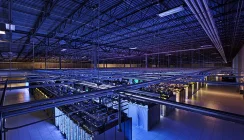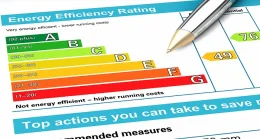Improving Server Room and Datacentre Energy Efficiency
Demand for on-site server rooms continues to grow at a similar pace to that for ‘Cloud’ based datacentre services. This may seem strange but not all organisations want to move their data processing operations to remote colocation datacentres (Colos). These organisations want to have their own ‘local’ operations and/or retain some aspect of control of their data and technologies are emerging to support this need including on-site micro-datacentres (self-contained cabinets that house all aspects of a datacentre or server room including connectivity, power, cooling and server racks). On-site server rooms and micro-datacentres are expected to form the on-site backbone for ‘Edge Computing’ and provide gateways for companies who want to connect their operations and devices to the Internet of Things (IoT).
In countries like the UK, the drive for greater energy efficiency in server rooms, datacentres and other types of buildings is gaining momentum. This is not only down to rising energy costs but also the strain growing demand for electricity (from the datacentre community and a growing population) is putting on an ageing national grid. UK power generating stations are closing to comply with EU directives for cleaner and non-carbon generated energy but at a pace behind which newer energy sources can be brought online. Nuclear power stations offer one alternative but can take up to 20 years from initial ground-break to commissioning. Renewable power sources including solar PV and wind turbines, provide alternative sources of power but can only boost grid reserves on a 24/7 basis when couple with suitable energy storage batteries.
Monitoring Energy Efficiency
In server rooms and datacentres, it is as true to say that ‘what you don’t monitor, you can’t control’ as in many other business and organisational functions. In datacentres and server rooms there are nearly always some ‘quick wins’ to be had from an initial energy efficiency drive but more often a formal, sustained approach is required.
A fundamental aspect for many building operators is to monitor their energy usage. Often this requires more than simply comparing the electricity meter bills and comparing kilo-Watt hour (kWh) usage at the Point of Common Coupling (PCC); typically known as the ‘building incomer’.
In a server room or datacentre environment it is important to install accurate sub-metering within the electrical infrastructure and to take this metering concept right through to the use of intelligent Power Distribution Units (PDUs) to which loads are connected. This approach to monitoring will generate a lot of data to feed into an building Energy Management System (EMS) or Data Centre Infrastructure Management (DCIM) package. The use of an EMS or DCIM dashboard and suitable metering provides the opportunity to track energy usage and identify areas for improvement. Monitoring also helps to provide a before and after scenario to energy usage improvement programs.
Energy Consumption and Efficiency Metrics
In a datacentre environment, the most common metric used is ‘PUE’ which stands for Power Usage Effectiveness. This is a relatively easy energy efficiency metric to calculate and track and uses the following formula:
PUE = Total Facility Power/ IT Equipment Power
Power Usage Effectiveness also provides a useful benchmark for comparing datacentre facilities. The closer the ratio is to Unity (1) the more efficient the datacentre. Some operators, including mega-datacentres claim to operate around 1.1 to 1.2 with most running around 1.5 to 2 or higher dependent on their age and the systems they run.
Energy Usage in A Datacentre
In any IT environment, whether it’s a Colo datacentre or on-site server room the two biggest power draws are from the IT equipment and the cooling systems required to keep the ‘white-space’ environment within a 20-25°C ambient environment. The latter being a comfortable working temperature for people.
The electrical power path within a datacentre or server room is known as the critical power path. This runs from the building incomer (PCC) and runs through LV switchboards, sub-distribution systems and power distribution units in server racks to which the IT loads are connected. Along this path uninterruptible power supplies (UPS systems) can be installed either as a single centralised system or distributed within the critical power path (‘decentralised’) with UPS systems allocated to specific rooms, server cabinet rows or housed within a server cabinet. Generators may also be installed as a further level of power back-up to the UPS systems and provide power to essential and non-essential loads including cooling and lighting.
All electrical equipment will generate heat as a by-product of their energy conversion process into useful ‘work’. Within a server cabinet and data processing environment, it is the servers themselves that generate the most heat. This must be removed from the server cabinets to prevent the risk of fire and from the room itself to maintain a suitable environment for people to work within. Any cooling system will be powered from the mains power supply and in the event of a power failure, from a standby power generator.
Steps to Improve Operating Energy Efficiency
Revisiting the PUE ratio for measuring energy efficiency, it is possible to see that improving the energy efficiency of the IT loads and the systems used within the total facility will lead to improvement of the final PUE ratio. The formula therefore provides two areas for an energy efficiency review:
- Power drawn by the IT/Server load
- Power drawn by support systems
One of the first ways to improve operating efficiency is to only run high efficiency systems including IT servers and UPS systems. The lower the losses from these systems the less the need for cooling. Less modern transformer-based UPS can run at only around 70-80% efficiency with more modern transformerless systems achieving up to 97.5% in on-line mode. With a potential energy saving of around 25% or more a UPS system upgrade can pay for itself within 3 years. New builds have the advantage of being able to install the latest high efficiency systems compared to existing sites must consider energy efficiency improvement and system upgrade plans.
Another important area of energy efficiency for IT managers is server utilisation and the use virtualisation technologies For servers with a low loading (low utilisation) there is a small power demand regardless of output in the form of data processing. Circuits are energised and fans running. Whilst under-utilised servers provide a form of redundancy in large or mega-datacentre this could lead to ‘wasted’ energy. A server usage audit can help to identify servers for potential removal. Virtualisation also provides opportunities to reduce the number of servers within a datacentre or server room facility.
As well as using efficient systems to reduce the demand placed on cool systems, there are several approaches that can be taken to the design of a datacentre or server room cooling system. One of the most important, dependent on geographic location, is the use of natural or free cooling. This uses cool air from the natural environment to support cooling for the facility. A second approach is to allow the ambient temperature to rise in line with the ASHRAE (https://www.ashrae.org/standards-research–technology/standards–guidelines) standard to a higher ambient than 20-25°C and for example towards 30°C.
Other cooling and air flow issues that can help improve operational energy efficiency include:
- air flow management at the room level and the use of hot/cold-aisle containment
- air flow at the rack level and the use of blanking plates/rear door heat exchangers
- air quality including room cleanliness and deep cleaning procedures and timetables
The same approach to using high efficiency systems can also be extended to other areas of general HVAC (heating ventilation and cooling) and support systems including lighting, security (CCTV) and access systems.
Energy efficiency is an important topic for server room and datacentre operators. The right approach to managing energy will lead to a higher PUE which can be important to colocation datacentres that need to differentiate themselves from other competitors for server facilities. Energy efficiency will also become more important for all UK businesses to reduce their operating costs and for certain sized companies as they must include a section on energy efficiency in their annual reports to Companies House.
For any organisation looking to improve its energy usage efficiency, it is important to engage with energy efficiency experts who can provide a wealth of information on the subject from the initial audit to system upgrades, process improvements and continuous energy monitoring systems. At Server Room Environments we provide a free energy usage audit service and through our consultants, access to the products and services any server room or datacentre facility needs to improve, monitor and manage its energy efficiency.


























